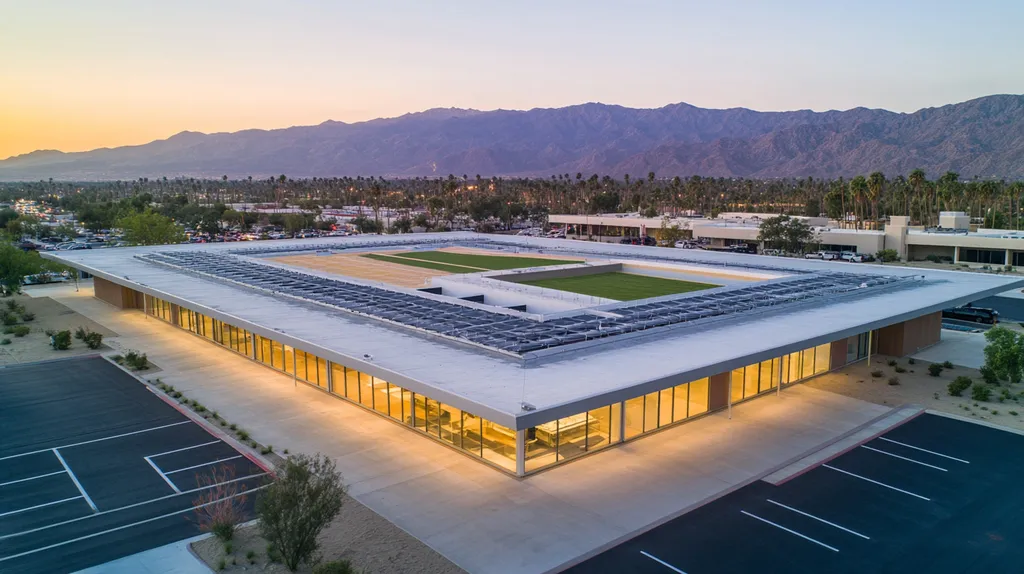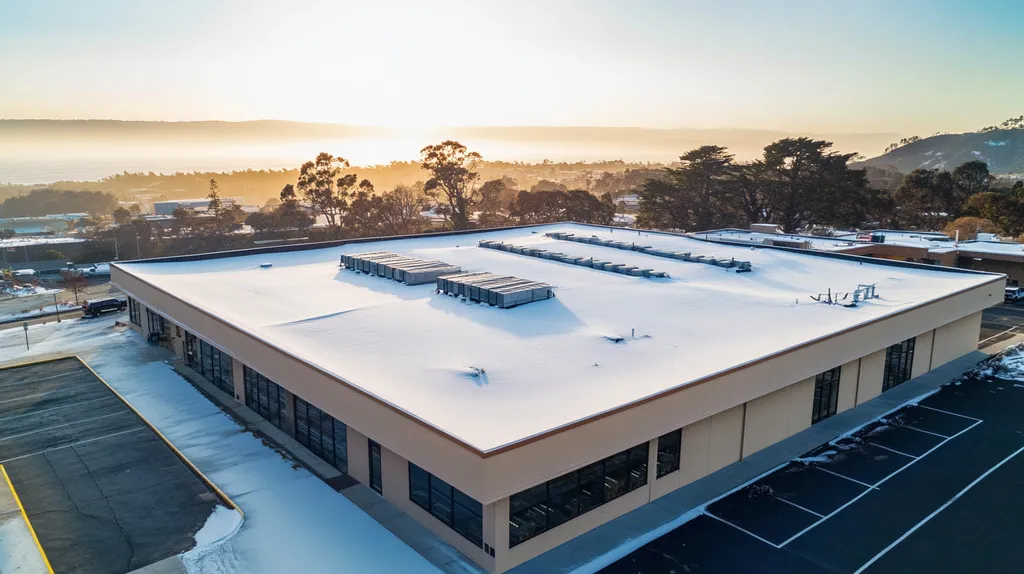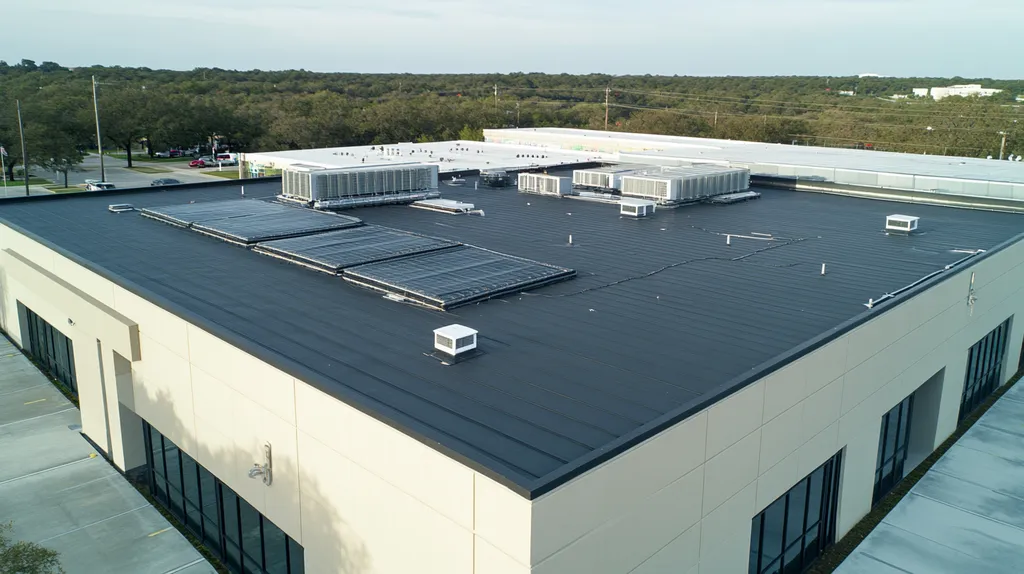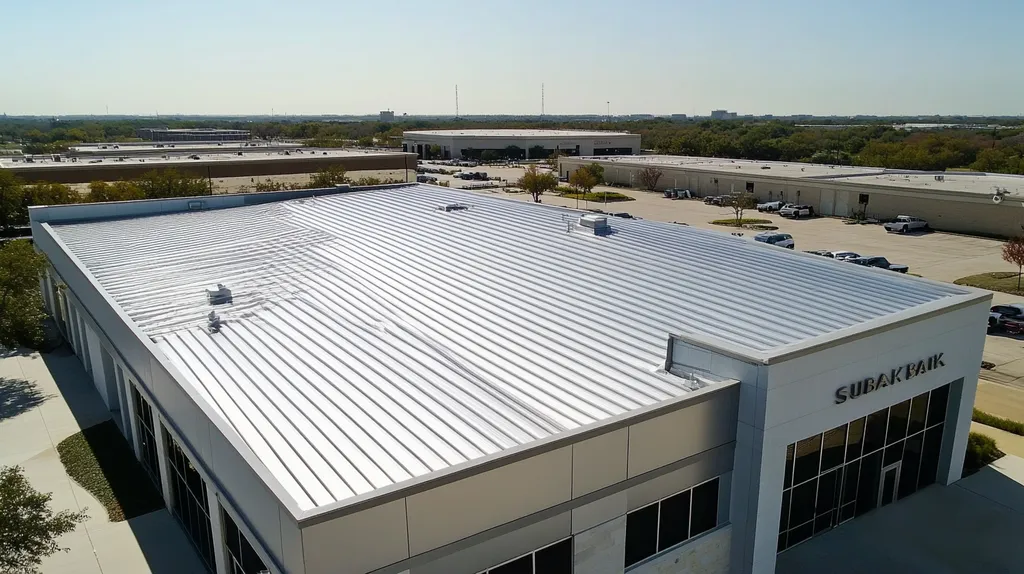Each year, industrial roof fires cause over $300 million in property damage and business interruption costs across North America. Despite this staggering toll, many facility managers overlook critical precautions that could prevent these catastrophic events.
From compromised roofing materials to inadequate maintenance protocols, multiple factors contribute to elevated fire risks in industrial settings. Understanding these hazards and implementing proper safeguards is essential for protecting both assets and occupants.
This comprehensive guide examines key performance factors, financial implications, compliance requirements, and operational procedures that facility managers must consider to effectively mitigate rooftop fire hazards.
SECTION 1: PERFORMANCE FACTORS
Fire hazards on industrial roofs present serious threats to both lives and property. With commercial properties representing over 20% of reported structure fires, awareness of the performance factors in roofing systems is essential for facility managers wanting to mitigate these risks. This section delves into three key areas: fire-resistant roofing materials, design vulnerabilities, and the impact of debris accumulation.
Fire-Resistant Roofing Materials
Selecting the right roofing materials is crucial for preventing fire hazards. Fire-resistant options, such as modified bitumen and metal roofing, help slow the spread of flames. This choice is especially important in high-risk environments.
Conversely, traditional materials like asphalt shingles often provide inadequate fire resistance, allowing flames to spread rapidly, which can escalate fire emergencies in industrial settings. Facility managers need to prioritize roofing materials that meet or exceed established fire safety standards.
Additionally, applying fire-retardant coatings to existing roofs can bolster their resistance to flames. These coatings are engineered to delay ignition and reduce flame spread when exposed to fire. Utilizing such measures can play a vital role in fire prevention.
Key Action Items
Roof Shape and Design Vulnerabilities
The structure and design of a roof can greatly affect fire hazards. Roofs that are flat, especially those with parapets, can trap heat and flames, accelerating the spread of fire across surfaces.
Moreover, intricate roof designs with multiple slopes can create hidden areas for debris accumulation, complicating fire suppression efforts. These features increase the potential risks during fire emergencies.
Facility managers are encouraged to assess their roofs for design vulnerabilities. Minor changes, such as enhancing drainage systems, can significantly reduce fire risks. Ensuring proper roof slopes can also help in clearing debris, further promoting safety.
Key Action Items
Impact of Debris Accumulation
Debris accumulation on industrial roofs is a significant fire hazard that is often overlooked. Organic materials like leaves and trash can ignite easily, creating a dangerous fuel source that could escalate fire risks.
To counteract these threats, routine cleaning and maintenance are essential. Facility managers should conduct regular inspections to identify and eliminate any potential hazards, promoting both safety and the longevity of the roofing system.
Failing to manage roof debris can lead to fire code violations and higher insurance premiums. Facility managers must understand that a neglected roof increases liability risks, putting both lives and property in jeopardy.
Key Action Items
SECTION 2: FINANCIAL CONSIDERATIONS
Understanding the financial implications of fire hazards on industrial roofs is crucial for facility managers. According to a report from the National Fire Protection Association, property damage from roof-related fires can soar into the millions each year. Taking proactive steps to invest in fire-resistant materials not only safeguards property but also makes sound economic sense. This section will examine the costs associated with fire-resistant materials, the economic fallout of roof fires, and the implications for insurance and liability.
Cost of Fire-Resistant Materials
Investing in fire-resistant roofing materials is essential, yet often underestimated by facility managers. Although the initial costs may exceed those of traditional roofing choices, such as asphalt shingles, fire-resistant options like metal roofing and modified bitumen significantly reduce the risk of fire damage. Over time, these materials can lead to considerable cost savings.
Fire-resistant roofs not only endure higher temperatures but often extend the lifespan of the roofing system, reducing long-term replacement expenses. Facilities utilizing these materials frequently report lower maintenance costs due to fewer fire-related incidents, making such investments financially advantageous.
Moreover, buildings with fire-resistant roofs may enhance property value, attracting tenants and buyers who prioritize safety. In a competitive market, this factor can improve marketability. Overall, investing in fire safety measures is a prudent financial strategy to prevent potential losses.
Key Action Items
Economic Impact of Roof Fires
The financial fallout from roof fires can be catastrophic. Estimates suggest that substantial fire damage can result in facility downtime costing businesses an average of $25,000 per day. In addition to repair or replacement costs, which can escalate into the six figures, the ripple effects can disrupt operations significantly.
Production halts not only lead to revenue loss but can also damage customer relationships and reduce employee morale. Unfulfilled commitments during recovery periods can strain business dynamics, creating a spiral of negative impacts.
Beyond the immediate costs, facility managers may also face fines from regulatory agencies and heightened scrutiny from local authorities. The lasting damage to brand reputation can detrimentally affect customer trust, which is often difficult to recover.
Key Action Items
Insurance and Liability Costs
Insurance plays a critical role in mitigating the financial risks linked to roof fires. However, inadequate fire safety measures can lead to soaring premiums, especially if a facility is deemed high-risk. Facilities utilizing non-fire-resistant materials may confront elevated liability costs that can directly impact financial stability.
In the event of a fire, navigating insurance claims can become complex and protracted. Facilities may find themselves not only facing rebuilding expenses but also an arduous journey to recover losses, which can hinder cash flow during crucial periods.
Furthermore, businesses may incur additional liability costs from operational interruptions or accidents stemming from neglected fire safety. As safety regulations evolve, so do potential legal liabilities, emphasizing the importance of compliance and appropriate insurance coverage.
Key Action Items
SECTION 3: COMPLIANCE REQUIREMENTS
Compliance requirements are essential for ensuring fire safety on industrial roofs. Failing to adhere to these standards can lead to catastrophic outcomes, posing risks to both property and lives. The National Fire Protection Association (NFPA) highlights that roofing materials and systems are linked to nearly 20% of fire-related damages in industrial settings. Thus, facility managers must understand building codes, regulatory requirements, and certification systems to effectively mitigate fire hazards.
Building Code Standards for Fire Resistance
Building codes act as the foundation for fire safety in roofing systems. These codes vary by region but generally establish minimum fire resistance ratings that enhance a facility’s safety. For instance, some jurisdictions mandate roofs to have a Class A fire rating, designed to withstand severe fire exposure.
Facility managers should be proactive in familiarizing themselves with both local and national building codes to ensure their roofs are compliant. Regular inspections and timely updates to existing roofs are crucial, especially since codes can be revised. Non-compliance not only risks hefty fines but also increases vulnerability during emergencies.
Moreover, the consequences of failing to meet these standards can extend beyond fines. Non-compliance may result in denied insurance claims and legal ramifications if an incident occurs due to ignored codes. Therefore, strict adherence to building codes is essential for both safety and financial protection.
Key Action Items
Regulatory Requirements for Roofing Materials
Awareness of regulatory requirements for roofing materials is crucial in reducing fire risks. Regulations often determine acceptable materials based on their fire performance and combustibility. For instance, materials like TPO and PVC are widely recognized for their resistance to fire and are specified in many fire safety codes.
Facility managers should consult with local authorities and fire marshals when selecting roofing materials to ensure compliance with regulations. This diligence helps avoid costly renovations and scrutiny later on. Proper installation is also vital, as it directly impacts safety; following manufacturer guidelines and hiring certified contractors is crucial.
Ultimately, maintaining compliance with these regulations can safeguard against fire hazards and related risks. By investing in compliant, high-performance materials, facility managers protect both their assets and the people within them.
Key Action Items
Certification and Rating Systems
Certification and rating systems are essential tools for measuring the fire resistance and safety of roofing systems. Organizations like Underwriters Laboratories (UL) and Factory Mutual (FM) provide rigorous testing and certification for roofing materials. These credentials guide facility managers in making informed product choices.
Products that have been certified typically boast fire rating labels, indicating their capacity to withstand fire exposure. Utilizing materials with high fire ratings can greatly diminish fire risk, thereby enhancing overall safety. Facility managers must prioritize seeking these certifications when evaluating roofing products.
Moreover, these rating systems evolve alongside technological advancements and updated fire codes. Staying educated about new materials and innovations is crucial for preemptively addressing fire hazards. Engaging with reputable suppliers to obtain updated certification information can significantly aid in achieving compliance.
Key Action Items
SECTION 4: RISK MANAGEMENT
Fire hazards on industrial roofs pose significant risks to both property and personnel. Statistics indicate that industrial facilities account for a high percentage of fire incidents, often resulting in catastrophic losses. Identifying and mitigating these risks is essential for safeguarding investments and ensuring workplace safety. This section emphasizes the importance of recognizing potential fire hazards, evaluating proximity to fire risks, and addressing electrical and HVAC concerns.
Identifying Potential Fire Hazards
Recognizing potential fire hazards on industrial roofs is vital for effective risk management. Common threats include buildups of flammable debris, poorly maintained roofing materials, and the presence of heat sources. Conducting regular inspections helps identify these risks before they escalate.
For instance, accumulated leaves or dust can ignite if exposed to sparks or heat. Additionally, roofs with inadequate drainage may trap combustible materials. Evaluating the materials used in roofing is equally essential, as some may be more susceptible to ignition.
Regular maintenance and assessments are crucial for fire hazard identification. Facility managers should establish schedules for cleaning and inspecting roofs to significantly minimize the likelihood of unexpected fire outbreaks. Focus on utilizing flame-resistant materials and adhering to local fire codes to enhance overall safety and compliance.
Key Action Items
Assessing Proximity to Fire Risks
Careful assessment of the proximity of industrial roofs to potential fire sources is crucial. Nearby structures, equipment, and landscaping can be significant fire hazards. Understanding these factors helps develop a comprehensive risk management strategy.
For example, facilities adjacent to heavy machinery may face increased risks due to operational sparks. Similarly, flammable vegetation nearby can facilitate the rapid spread of flames. Conducting a thorough evaluation of the surrounding environment is necessary for targeted interventions.
Facility managers should also consider local climate conditions that can impact fire risk. Areas with dry conditions or strong winds could exacerbate fire spread, emphasizing the need for heightened caution. Engaging with local fire departments can provide valuable insights into specific risks in the area.
Key Action Items
Mitigating Electrical and HVAC Risks
Electrical and HVAC systems can pose significant fire hazards if not properly managed. Issues such as faulty wiring, overloaded circuits, and malfunctioning HVAC components are common culprits in industrial fires. Recognizing these risks is essential for effective fire prevention.
Facility managers should conduct regular inspections of electrical systems. Ensuring wiring is up to code can significantly reduce the risk of short circuits or overheating. Investing in quality circuit breakers and overload protection is advisable.
HVAC systems also require meticulous maintenance. Regular filter replacements and duct cleaning can prevent overheating and accumulation of flammable debris. It’s crucial to have trained personnel conduct these inspections to catch early warning signs.
Key Action Items
SECTION 5: OPERATIONAL PROCEDURES
Addressing fire hazards on industrial roofs requires diligence from facility managers. Roof fires account for approximately 15% of all structure fires, emphasizing the importance of regular operational procedures. This section outlines vital practices, including frequent inspections, timely repairs, and effective management of rooftop systems.
Regular Roof Inspections and Maintenance
Regular inspections are crucial for identifying potential fire hazards on industrial roofs. Facility managers should establish a routine inspection schedule, ideally twice a year, typically in the spring and fall, to detect issues such as debris buildup that can easily ignite.
Roof punctures and tears can allow moisture to compromise insulation materials, raising fire risks. During inspections, closely examine seams, flashing, and penetrations, ensuring fire barriers are intact. Engaging a qualified roofing specialist can enhance inspection effectiveness and identify hidden problems.
In addition to inspections, maintenance tasks like cleaning gutters and drains are essential. Clogged drainage can lead to water pooling, resulting in mold and mildew, which increases fire hazards if not addressed promptly. Tracking inspection findings ensures informed maintenance decisions and proactive management.
Key Action Items
Prompt Repair of Roof Damage and Leaks
Immediate attention to roof damage is critical for minimizing fire risks. Leaks and tears can expose flammable materials, escalating the likelihood of ignition. Property managers must prioritize repairs as soon as damage is discovered, implementing clear protocols for emergencies.
Establishing an emergency repair team is advisable to address urgent situations effectively. Quick action can prevent minor issues from evolving into serious problems, preserving the integrity of fire-resistant materials that can degrade over time.
Choosing fire-resistant materials for repairs can further enhance safety. Applying fire-retardant coatings in high-risk areas adds an additional layer of protection. Regular reviews of repair history help identify recurring issues that need proactive intervention.
Key Action Items
Managing Rooftop Electrical and HVAC Systems
Rooftop electrical and HVAC systems can be significant fire hazards if not properly managed. Regular inspections are critical to identify wiring issues, overheating components, or malfunctioning equipment that may increase risk. It’s vital to secure cables to prevent damage from foot traffic or environmental conditions.
Additionally, clearing debris from HVAC units is essential to ensure they function correctly. Obstructions can restrict ventilation, leading to overheating and potential fires. Facility managers should engage licensed professionals for routine maintenance and inspections of these systems.
Training staff on safety protocols related to electrical and HVAC systems enhances awareness and improves risk management practices. Informed personnel are better positioned to identify potential hazards before they escalate into dangerous situations.
Key Action Items
SECTION 5: OPERATIONAL PROCEDURES
Addressing fire hazards on industrial roofs requires proactive measures from facility managers. The National Fire Protection Association reports that roof fires account for approximately 15% of all structure fires. Establishing regular operational procedures can significantly mitigate these risks. This section emphasizes critical practices such as inspections, timely repairs, and effective management of rooftop systems.
Regular Roof Inspections and Maintenance
Consistent roof inspections are essential for identifying potential fire hazards. Facility managers should implement a routine inspection schedule at least twice a year, ideally in spring and fall. These inspections can help uncover issues like debris accumulation, which can easily ignite under certain conditions.
Roof punctures and tears can allow moisture to compromise insulation materials, increasing fire risks. During inspections, thoroughly examine seams, flashing, and penetrations, ensuring fire barriers are intact. Collaborating with a qualified roofing specialist can enhance the inspection’s effectiveness by identifying hidden problems.
In addition to biannual inspections, maintenance tasks like cleaning gutters and drains are crucial. Clogged drainage can lead to water pooling, which not only damages the roof’s integrity but also fosters mold and mildew, raising fire hazards if left unattended.
Documenting inspection findings is vital for tracking issues over time. Keeping detailed logs allows for better planning of maintenance and informed decisions about potential renovations or replacements as needed.
Key Action Items
Prompt Repair of Roof Damage and Leaks
Timely attention to roof damage is critical for minimizing fire risks. Leaks and tears can expose flammable materials and increase the likelihood of ignition. Facility managers must prioritize repairs immediately upon discovering any damage and establish clear protocols for emergency situations.
Creating an emergency repair team that is readily available for urgent situations can facilitate immediate action. Quick responses can prevent minor issues from evolving into significant problems, preserving the integrity of fire-resistant materials that may degrade over time.
Selecting fire-resistant materials for repairs can provide an extra layer of safety. Additionally, applying fire-retardant coatings in high-risk areas enhances overall fire protection.
Regularly reviewing the facility’s repair history can highlight problem areas that require proactive management. This record can guide future strategic planning and budget allocation, ultimately helping to diminish fire hazards.
Key Action Items
Managing Rooftop Electrical and HVAC Systems
Rooftop electrical and HVAC systems can be significant fire hazards if not properly managed. Regular inspections are crucial for identifying issues such as faulty wiring, overheating components, or malfunctioning equipment that may pose risks. It is essential to secure cables to prevent damage from foot traffic or environmental factors.
Clearing debris from HVAC units is also critical to ensure proper function. Any obstruction can restrict ventilation, leading to overheating and increased fire risk if not addressed appropriately.
Facility managers should establish maintenance contracts with licensed professionals to ensure that these systems receive routine inspections and servicing. This proactive approach significantly reduces the likelihood of equipment failures, which are often the root causes of rooftop fires.
Training staff responsible for roof maintenance on safety protocols related to electrical and HVAC systems enhances awareness and improves risk management practices. Informed personnel can more effectively identify potential hazards before they escalate into dangerous situations.
Key Action Items
The Bottom Line
Industrial roof fires cause over $300 million in annual damages, yet most are preventable through proper precautions and maintenance protocols.
Fire-resistant materials, regular inspections, and strict compliance with building codes form the foundation of an effective fire prevention strategy.
Facility managers must recognize that investing in fire safety measures costs significantly less than recovering from a catastrophic roof fire, which can exceed $25,000 per day in business interruption costs alone.
Moving forward, organizations should prioritize comprehensive fire prevention through material selection, maintenance schedules, and staff training while maintaining detailed documentation of all fire safety measures.
The stakes are simply too high to neglect these critical precautions – lives, property, and business continuity all depend on proper fire hazard mitigation.
FREQUENTLY ASKED QUESTIONS
Q. What fire-resistant materials are best for a commercial roof?
A. Selecting materials like modified bitumen and metal roofing is crucial for effective fire resistance. They help slow fire spread, which is especially important in commercial settings. Traditional materials, such as asphalt shingles, may not provide the necessary protection.
Q. How can I reduce the costs associated with my industrial roof?
A. Investing in fire-resistant materials can lower maintenance and insurance costs over time. While the initial expense may be higher, these options often lead to significant savings by reducing fire-related incidents and repairs.
Q. What are the compliance requirements for industrial roofs?
A. Compliance requirements include following local building codes and fire safety regulations. Familiarizing yourself with these guidelines is essential to ensure that your roofing materials and installation methods meet safety standards.
Q. How can I identify fire hazards on my industrial roof?
A. Regular inspections can help identify fire hazards, such as flammable debris or old materials. Establishing a routine for checks will ensure that small issues are caught early before they escalate into serious problems.
Q. What are effective operational procedures for fire safety?
A. Establish regular inspection schedules, prompt repair protocols, and maintenance of electrical and HVAC systems. Maintaining detailed records ensures accountability and fosters a proactive approach to fire safety management.
Q. How should I manage debris on an industrial roof?
A. Regularly schedule roof cleaning to remove debris and organic materials that pose fire risks. Implementing a cleaning program helps avoid the accumulation that can ignite under certain conditions, contributing to overall fire safety.
Q. What training should staff undergo for fire safety?
A. Staff should be trained on fire hazard identification, safety protocols, and emergency procedures. Regular workshops can help ensure they remain vigilant and capable of responding effectively to potential fire threats.











